I have data as real and imaginary parts of complex number, and I want to fit them according to a complex function. More in detail, they are data from electrochemical impedance spectroscopy (EIS) experiments, and the function comes from an equivalent circuit. I am using Octave 7.2.0 in a Windows 10 computer. I need to use the leasqr algorithm, present in the Optim package. The leasqr used the Levenberg-Marquardt nonlinear regression, typical in EIS data fitting. Regarding the data, xdata are linear frequency, y data are ReZ + j*ImZ. If I try to fit the complex data with the complex fitting function, I get the following error:
error: weighted residuals are not real
error: called from
__lm_svd__ at line 147 column 20
leasqr at line 662 column 25
Code_for_StackOverflow at line 47 column 73
I tried to fit the real part of the data with the real part of the fitting function, and the imaginary parts of the data, with the imaginary part of the function. The fits are successfully performed, but I have two sets of fitted parameters, while I need only one set. Here the code I wrote.
clear -a;
clf;
clc;
pkg load optim;
pkg load symbolic;
Linear_freq = [1051.432, 394.2871, 112.6535, 39.42871, 11.59668, 3.458659, 1.065641, 0.3258571, 0.1000221];
ReZ = [84.10412, 102.0962, 178.8031, 283.0663, 366.7088, 431.3653, 514.4105, 650.5853, 895.9588];
MinusImZ = [27.84804, 59.56786, 116.5972, 123.2293, 102.6806, 117.4836, 178.1147, 306.256, 551.2337];
Z = [88.5946744, 118.2030626, 213.4606653, 308.7264008, 380.8131426, 447.0776424, 544.3739605, 719.0646495, 1051.950932];
MinusPhase = [18.32042302, 30.26135402, 33.1083029, 23.52528583, 15.64255593, 15.23515301, 19.09841797, 25.2082044, 31.60167787];
ImZ = -MinusImZ;
Angular_freq = 2*pi*Linear_freq;
xdata = Angular_freq;
ydata = ReZ + j*ImZ;
Fitting_Function = @(xdata, p) (p(1) + ((p(2) + (1./(p(3)*(j*xdata).^0.5))).^-1 + (1./(p(4)*(j*xdata).^p(5))).^-1).^-1);
p = [80, 300, 6.63E-3, 5E-5, 0.8]; # True parameters values, taken with a dedicated software: 76, 283, 1.63E-3, 1.5E-5, 0.876
options.fract_prec = [0.0005, 0.0005, 0.0005, 0.0005, 0.0005].';
niter=400;
tol=1E-12;
dFdp="dfdp";
dp=1E-9*ones(size(p));
wt = abs(sqrt(ydata).^-1);
#[Fitted_Parameters_ReZ pfit_real cvg_real iter_real corp_real covp_real covr_real stdresid_real z_real r2_real] = leasqr(xdata, ReZ, p, Fitting_Function_ReZ, tol, niter, wt, dp, dFdp, options);
#[Fitted_Parameters_ImZ pfit_imag cvg_imag iter_imag corp_imag covp_imag covr_imag stdresid_imag z_imag r2_imag] = leasqr(xdata, ImZ, p, Fitting_Function_ImZ, tol, niter, wt, dp, dFdp, options);
[Fitted_Parameters pfit cvg iter corp covp covr stdresid z r2] = leasqr(xdata, ydata, p, Fitting_Function, tol, niter, wt, dp, dFdp, options);
#########################################################################
# Calculate the fitted functions, with the fitted paramteres array
#########################################################################
Fitted_Function_Real = real(pfit_real(1) + ((pfit_real(2) + (1./(pfit_real(3)*(j*xdata).^0.5))).^-1 + (1./(pfit_real(4)*(j*xdata).^pfit_real(5))).^-1).^-1);
Fitted_Function_Imag = imag(pfit_imag(1) + ((pfit_imag(2) + (1./(pfit_imag(3)*(j*xdata).^0.5))).^-1 + (1./(pfit_imag(4)*(j*xdata).^pfit_imag(5))).^-1).^-1);
Fitted_Function = Fitted_Function_Real + j.*Fitted_Function_Imag;
Fitted_Function_Mod = abs(Fitted_Function);
Fitted_Function_Phase = (-(angle(Fitted_Function))*(180./pi));
################################################################################
# Calculate the residuals, from https://iopscience.iop.org/article/10.1149/1.2044210
# An optimum fit is obtained when the residuals are spread randomly around the log Omega axis.
# When the residuals show a systematic deviation from the horizontal axis, e.g., by forming
# a "trace" around, above, or below the log co axis, the complex nonlinear least squares (CNLS) fit is not adequate.
################################################################################
Residuals_Real = (ReZ-Fitted_Function_Real)./Fitted_Function_Mod;
Residuals_Imag = (ImZ-Fitted_Function_Imag)./Fitted_Function_Mod;
################################################################################
# Calculate the chi-squared - reduced value, with the fitted paramteres array NOVA manual page 452
################################################################################
chi_squared_ReZ = sum(((ReZ-Fitted_Function_Real).^2)./Z.^2)
chi_squared_ImZ = sum(((ImZ-Fitted_Function_Imag).^2)./Z.^2)
Pseudo_chi_squared = sum((((ReZ-Fitted_Function_Real).^2)+((ImZ-Fitted_Function_Imag).^2))./Z.^2)
disp('The values of the parameters after the fit of the real function are '), disp(pfit_real);
disp('The values of the parameters after the fit of the imaginary function are '), disp(pfit_imag);
disp("R^2, the coefficient of multiple determination, intercept form (not suitable for non-real residuals) is "), disp(r2_real), disp(r2_imag);
###################################################
## PLOT Data and the Function
###################################################
#Set plot parameters
set(0, "defaultlinelinewidth", 1);
set(0, "defaulttextfontname", "Verdana");
set(0, "defaulttextfontsize", 20);
set(0, "DefaultAxesFontName", "Verdana");
set(0, 'DefaultAxesFontSize', 12);
figure(1);
## Nyquist plot (Argand diagram)
subplot(1,2,1, "align");
plot((ReZ), (MinusImZ), "o", "markersize", 2, (Fitted_Function_Real), -(Fitted_Function_Imag), "-k");
axis ("square");
grid on;
daspect([1 1 2]);
title ('Nyquist Plot - Argand Diagram');
xlabel ('Z'' / \Omega' , 'interpreter', 'tex');
ylabel ('-Z'''' / \Omega', 'interpreter', 'tex');
## Bode Modulus
subplot (2, 2, 2);
loglog((Linear_freq), (Z), "o", "markersize", 2, (Linear_freq), (Fitted_Function_Mod), "-k");
grid on;
title ('Bode Plot - Modulus');
xlabel ('\nu (Hz)' , 'interpreter', 'tex');
ylabel ('|Z| / \Omega', 'interpreter', 'tex');
## Bode Phase
subplot (2, 2, 4);
semilogx((Linear_freq), (MinusPhase), "o", "markersize", 2, (Linear_freq), (Fitted_Function_Phase), "-k");
set(gca,'YTick',0:10:90);
grid on;
title ('Bode Plot - Phase');
xlabel ('\nu (Hz)' , 'interpreter', 'tex');
ylabel ('-\theta (°)', 'interpreter', 'tex');
figure(2)
## Bode Z'
subplot (2, 1, 1);
semilogx((Linear_freq), (ReZ), "o", "markersize", 2, (Linear_freq), (Fitted_Function_Real), "-k");
grid on;
title ('Bode Plot Z''');
xlabel ('\nu (Hz)' , 'interpreter', 'tex');
ylabel ('Z'' / \Omega', 'interpreter', 'tex');
## Bode -Z''
subplot (2, 1, 2);
#subplot (2, 2, 4);
semilogx((Linear_freq), (MinusImZ), "o", "markersize", 2, (Linear_freq), -(Fitted_Function_Imag), "-k");
grid on;
title ('Bode Plot -Z''''');
xlabel ('\nu (Hz)' , 'interpreter', 'tex');
ylabel ('-Z'''' / \Omega', 'interpreter', 'tex');
figure(3)
## Residuals Real
subplot (2, 1, 1);
semilogx((Angular_freq), (Residuals_Real), "-o", "markersize", 2);
grid on;
title ('Residuals Real');
xlabel ('\omega (Hz)' , 'interpreter', 'tex');
ylabel ('\Delta_{re} / \Omega', 'interpreter', 'tex');
## Residuals Imaginary
subplot (2, 1, 2);
#subplot (2, 2, 4);
semilogx((Angular_freq), (Residuals_Imag), "-o", "markersize", 2);
grid on;
title ('Residuals Imaginary');
xlabel ('\omega (Hz)' , 'interpreter', 'tex');
ylabel ('\Delta_{im} / \Omega', 'interpreter', 'tex');
Octave should be able to handle complex numbers. What do I do wrong? I was thinking to fit the real part of the data with the real part of the fitting function, and then using the Kramers-Kronig relations to get the imaginary part of the fitted function, but I would like to avoid this method, if possible.
Any help would be greatly appreciated, thanks in advance.




